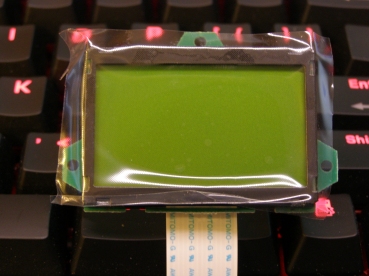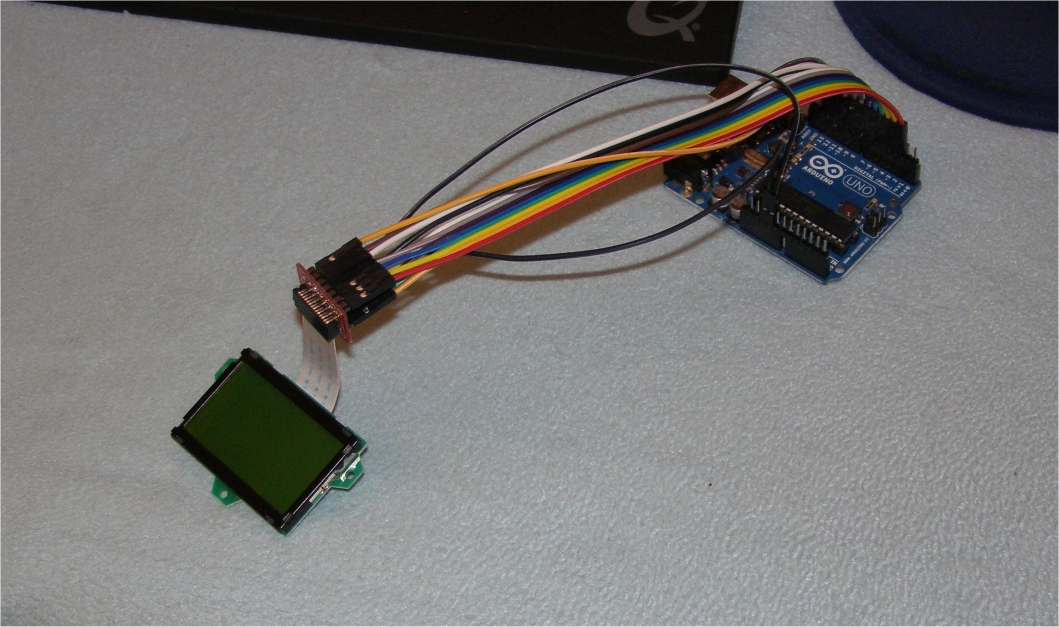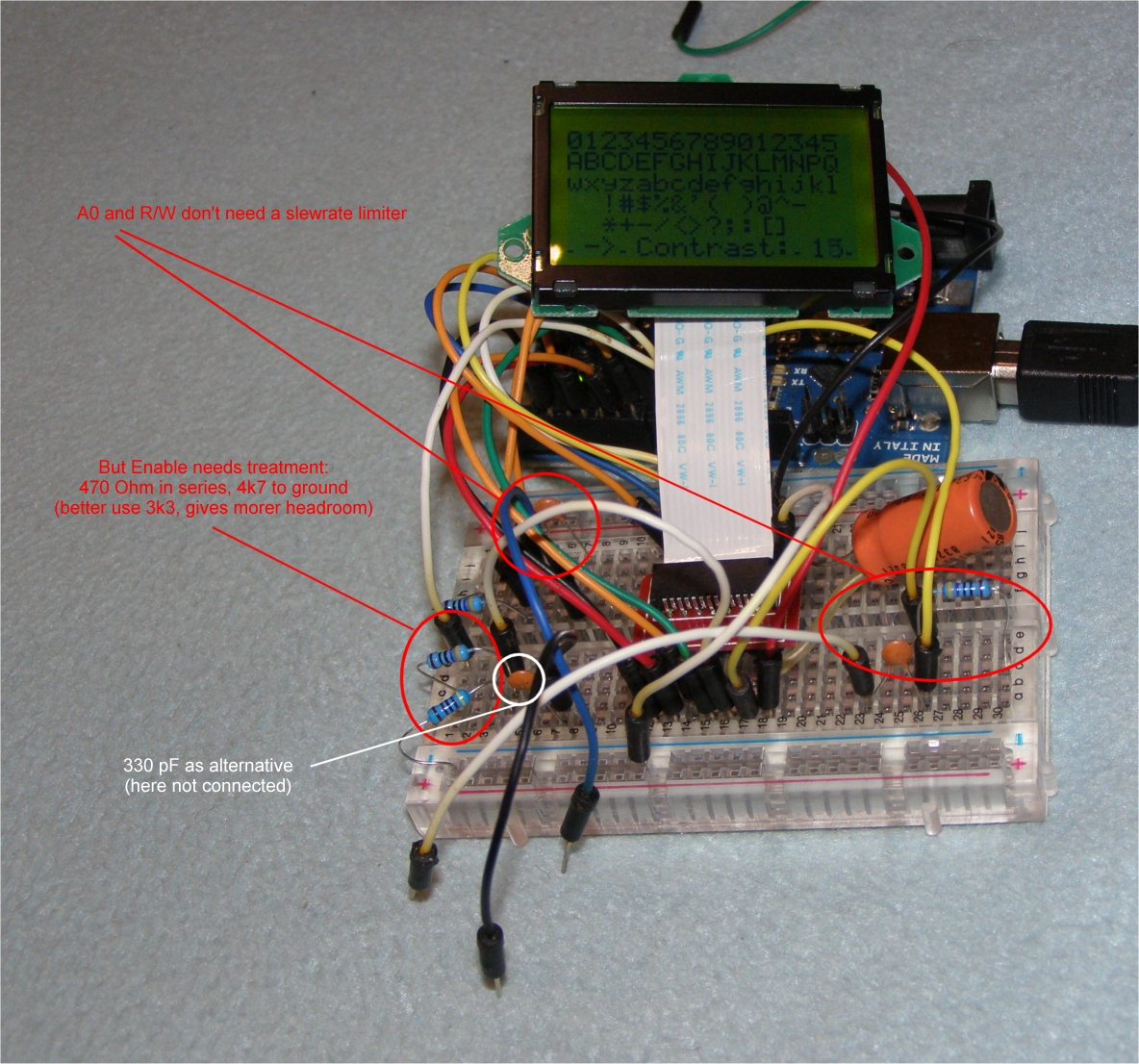Graphic display 100 x 48 pixels + 5 symbols
based on an Epson SED1531 LCD-controller
!!!! Page updated with Arduino code: scroll down !!!!

I used the good work of sayang , alias Roland van Leusden.
The BascomAVR program has changed on a few aspects:
1. got rid of the long waits: 200ms at the start is sufficient
2. proper handling of E and shortened to 200ns pulsewidth < corrected typo >
3. reading busy-flag read |||| cancelled that in Test8: not necessary
4. added scrolling
5. testing ram readback
Test7 uses the Busy-check and is available for reference purposes
Test8 is what I use now, no more Busy-check but short delays where necessary.
Suitable for Tiny and Mega AVR's upto 20MHz clockspeed, not tested yet with Xmega @ 32 MHz
Thanks to Marco/Patrick/Peter van Merkerk for his excellent library in C
and especially what I learned from it ....
Arduino sketch Glcd1531_Plons_revA:
Click here to download the zipped sketch; the _ino at the end of the filename is to distinguish it from this plain zipped txt version
And just to be sure: here the HTML export of the sketch
// Glcd1531_Plons_revA
// Based on the library published by TkkrLab on http://tkkrlab.nl/wiki/Glcd_48x100
// Adaptations by Plons (Nard Awater); Feb 23, 2013
// Published on http://www.aplomb.nl/TechStuff/graph_lcd_MvN/sed1531_graph_lcd/sed1531_graph_lcd.html
// Feel free to copy the contents of the webpage above, to publish it on a wiki where it can be found easier
// Leave this header in as reference to where it came from.
// There were two problems in the original code
// 1. Incorrect handling of the Enable line of the display
// 2. By powering the display with Digital13, this pin has to supply too much current when the Backlight is turned on
// Then there were a few other things that have been modified
// 3. Got rid of the unnecessary long delays and shortened other
// 4. Added a blank column between adjacent characters
// Then there was a problem that was harder to track down: latch-up of the display controller SED1531 by an overshoot of the E-signal.
// The reason I came to suspect this latch-up phenomenae, is that my own AVR board, with a Bascom program, doesn't suffer from this.
// When I adapted the TkkrLab library to work simular as my Bascom program, I needed to power the display with Digital13, in order to make it work.
// And that was odd.
// The length of the connections between AVR and display is just a few cm's on my own board. On the Arduino I used 12cm jumper wires.
// AVR's do not just have powerfull output drivers, but these buggers are fast too.
// That, combined with the few cm's extra wire, was enough to make the E-signal overshoot: and this overshoot is the cause of the latch-up
// Latch-up is nasty: it can destroy a chip. And to get a latched-up circuit working again, you need to power down, wait a while and then power up again.
// More info here: http://en.wikipedia.org/wiki/Latchup
// Bascically, all signals can cause this latch-up, but I found that E is the most susceptable one.
//
// Now the fix:
// ------
// Digital10 ------| |---------------------------------------------------------- pin 6 == Enable
// ------ | |
// 470R | |
// --- |
// | | 3k3 -----
// Arduino | | or use a capacitor ----- Display
// --- of 330 pF |
// | |
// | |
// Gnd ---------------------------------------------------------------------------- pin 1 == Gnd
//
// Both solutions work. Personally I prefer the resistive divider, but technically the slewrate-limiter
// with 470 Ohm and 330 pF to ground is an acceptable cure as well.
// Note to Duality (who published additional code on http://tkkrlab.nl/wiki/Glcd_48x100
// Your problem with the display going blank is most likely due to this latch-up phenomenon
// Here we go:
int lcdA0 = 12;
int lcdRW = 11;
int lcdEnable = 10;
// int displayPower = 13;
// INSTEAD: Connect Vcc-pin of display to +5V on the Arduino
int lcdDataPins[] = {9,8,7,6,5,4,3,2};
char str[] = " "; // was 20 char's long, now 17
// 5x7 Font
byte lcdFonts[][5] = {
{ 0x00 , 0x00 , 0x00 , 0x00 , 0x00 },
{ 0x00 , 0x00 , 0x5F , 0x00 , 0x00 },
{ 0x00 , 0x07 , 0x00 , 0x07 , 0x00 },
{ 0x14 , 0x7F , 0x14 , 0x7F , 0x14 },
{ 0x24 , 0x2A , 0x7F , 0x2A , 0x12 },
{ 0x23 , 0x13 , 0x08 , 0x64 , 0x62 },
{ 0x36 , 0x49 , 0x55 , 0x22 , 0x50 },
{ 0x00 , 0x05 , 0x03 , 0x00 , 0x00 },
{ 0x00 , 0x1C , 0x22 , 0x41 , 0x00 },
{ 0x00 , 0x41 , 0x22 , 0x1C , 0x00 },
{ 0x08 , 0x2A , 0x1C , 0x2A , 0x08 },
{ 0x08 , 0x08 , 0x3E , 0x08 , 0x08 },
{ 0x00 , 0x50 , 0x30 , 0x00 , 0x00 },
{ 0x08 , 0x08 , 0x08 , 0x08 , 0x08 },
{ 0x00 , 0x60 , 0x60 , 0x00 , 0x00 },
{ 0x20 , 0x10 , 0x08 , 0x04 , 0x02 },
{ 0x3E , 0x51 , 0x49 , 0x45 , 0x3E },
{ 0x00 , 0x42 , 0x7F , 0x40 , 0x00 },
{ 0x42 , 0x61 , 0x51 , 0x49 , 0x46 },
{ 0x21 , 0x41 , 0x45 , 0x4B , 0x31 },
{ 0x18 , 0x14 , 0x12 , 0x7F , 0x10 },
{ 0x27 , 0x45 , 0x45 , 0x45 , 0x39 },
{ 0x3C , 0x4A , 0x49 , 0x49 , 0x30 },
{ 0x01 , 0x71 , 0x09 , 0x05 , 0x03 },
{ 0x36 , 0x49 , 0x49 , 0x49 , 0x36 },
{ 0x06 , 0x49 , 0x49 , 0x29 , 0x1E },
{ 0x00 , 0x36 , 0x36 , 0x00 , 0x00 },
{ 0x00 , 0x56 , 0x36 , 0x00 , 0x00 },
{ 0x00 , 0x08 , 0x14 , 0x22 , 0x41 },
{ 0x14 , 0x14 , 0x14 , 0x14 , 0x14 },
{ 0x41 , 0x22 , 0x14 , 0x08 , 0x00 },
{ 0x02 , 0x01 , 0x51 , 0x09 , 0x06 },
{ 0x32 , 0x49 , 0x79 , 0x41 , 0x3E },
{ 0x7E , 0x11 , 0x11 , 0x11 , 0x7E },
{ 0x7F , 0x49 , 0x49 , 0x49 , 0x36 },
{ 0x3E , 0x41 , 0x41 , 0x41 , 0x22 },
{ 0x7F , 0x41 , 0x41 , 0x22 , 0x1C },
{ 0x7F , 0x49 , 0x49 , 0x49 , 0x41 },
{ 0x7F , 0x09 , 0x09 , 0x01 , 0x01 },
{ 0x3E , 0x41 , 0x41 , 0x51 , 0x32 },
{ 0x7F , 0x08 , 0x08 , 0x08 , 0x7F },
{ 0x00 , 0x41 , 0x7F , 0x41 , 0x00 },
{ 0x20 , 0x40 , 0x41 , 0x3F , 0x01 },
{ 0x7F , 0x08 , 0x14 , 0x22 , 0x41 },
{ 0x7F , 0x40 , 0x40 , 0x40 , 0x40 },
{ 0x7F , 0x02 , 0x04 , 0x02 , 0x7F },
{ 0x7F , 0x04 , 0x08 , 0x10 , 0x7F },
{ 0x3E , 0x41 , 0x41 , 0x41 , 0x3E },
{ 0x7F , 0x09 , 0x09 , 0x09 , 0x06 },
{ 0x3E , 0x41 , 0x51 , 0x21 , 0x5E },
{ 0x7F , 0x09 , 0x19 , 0x29 , 0x46 },
{ 0x46 , 0x49 , 0x49 , 0x49 , 0x31 },
{ 0x01 , 0x01 , 0x7F , 0x01 , 0x01 },
{ 0x3F , 0x40 , 0x40 , 0x40 , 0x3F },
{ 0x1F , 0x20 , 0x40 , 0x20 , 0x1F },
{ 0x7F , 0x20 , 0x18 , 0x20 , 0x7F },
{ 0x63 , 0x14 , 0x08 , 0x14 , 0x63 },
{ 0x03 , 0x04 , 0x78 , 0x04 , 0x03 },
{ 0x61 , 0x51 , 0x49 , 0x45 , 0x43 },
{ 0x00 , 0x00 , 0x7F , 0x41 , 0x41 },
{ 0x02 , 0x04 , 0x08 , 0x10 , 0x20 },
{ 0x41 , 0x41 , 0x7F , 0x00 , 0x00 },
{ 0x04 , 0x02 , 0x01 , 0x02 , 0x04 },
{ 0x40 , 0x40 , 0x40 , 0x40 , 0x40 },
{ 0x00 , 0x01 , 0x02 , 0x04 , 0x00 },
{ 0x20 , 0x54 , 0x54 , 0x54 , 0x78 },
{ 0x7F , 0x48 , 0x44 , 0x44 , 0x38 },
{ 0x38 , 0x44 , 0x44 , 0x44 , 0x20 },
{ 0x38 , 0x44 , 0x44 , 0x48 , 0x7F },
{ 0x38 , 0x54 , 0x54 , 0x54 , 0x18 },
{ 0x08 , 0x7E , 0x09 , 0x01 , 0x02 },
{ 0x08 , 0x14 , 0x54 , 0x54 , 0x3C },
{ 0x7F , 0x08 , 0x04 , 0x04 , 0x78 },
{ 0x00 , 0x44 , 0x7D , 0x40 , 0x00 },
{ 0x20 , 0x40 , 0x44 , 0x3D , 0x00 },
{ 0x00 , 0x7F , 0x10 , 0x28 , 0x44 },
{ 0x00 , 0x41 , 0x7F , 0x40 , 0x00 },
{ 0x7C , 0x04 , 0x18 , 0x04 , 0x78 },
{ 0x7C , 0x08 , 0x04 , 0x04 , 0x78 },
{ 0x38 , 0x44 , 0x44 , 0x44 , 0x38 },
{ 0x7C , 0x14 , 0x14 , 0x14 , 0x08 },
{ 0x08 , 0x14 , 0x14 , 0x18 , 0x7C },
{ 0x7C , 0x08 , 0x04 , 0x04 , 0x08 },
{ 0x48 , 0x54 , 0x54 , 0x54 , 0x20 },
{ 0x04 , 0x3F , 0x44 , 0x40 , 0x20 },
{ 0x3C , 0x40 , 0x40 , 0x20 , 0x7C },
{ 0x1C , 0x20 , 0x40 , 0x20 , 0x1C },
{ 0x3C , 0x40 , 0x30 , 0x40 , 0x3C },
{ 0x44 , 0x28 , 0x10 , 0x28 , 0x44 },
{ 0x0C , 0x50 , 0x50 , 0x50 , 0x3C },
{ 0x44 , 0x64 , 0x54 , 0x4C , 0x44 },
{ 0x00 , 0x08 , 0x36 , 0x41 , 0x00 },
{ 0x00 , 0x00 , 0x7F , 0x00 , 0x00 },
{ 0x00 , 0x41 , 0x36 , 0x08 , 0x00 },
{ 0x08 , 0x08 , 0x2A , 0x1C , 0x08 },
{ 0x08 , 0x1C , 0x2A , 0x08 , 0x08 }
};
void setup() {
pinMode(lcdA0, OUTPUT);
pinMode(lcdRW, OUTPUT);
pinMode(lcdEnable, OUTPUT);
// pinMode(displayPower, OUTPUT); // no longer used
for (int i = 0; i <= 7; i++) {
pinMode(lcdDataPins[i], OUTPUT);
}
// Define a safe setting of control lines at the very beginning
digitalWrite(lcdEnable, LOW);
digitalWrite(lcdRW, HIGH);
digitalWrite(lcdA0, LOW);
//digitalWrite(displayPower, LOW);
//delay(2000);
//digitalWrite(displayPower, HIGH);
delay(200); //yes, this is sufficient
lcdInit();
//delay(1000);
writeClearLines(); // agreed, not really a clear but a kind of clear ;-)
// just to get visual evidence that this part is executed
delay(3000);
writeSomeText(); // now do the SomeText - field
}
void loop() {
for (int l = 0; l <= 3; l++) {
for (byte i = 1; i <= 6; i++) {
setMarker(i, true);
delay(400);
setMarker(i, false);
delay(100);
}
}
setRow(6);
for( byte j = 1; j <= 4; j++) {
invertDisplay(true);
delay(400);
lcdChar("*-*-LCD REVERSED-*-*");
invertDisplay(false);
delay(800);
resetColumnAdress();
lcdChar("#-#-#-LCD NORMAL-#-#");
invertDisplay(true);
}
for (int k = 0; k < 32; k++) {
writeLCDcontrast(k);
setLCDcontrast(k);
delay(250);
}
for (int k = 31; k >= 0; k --) {
writeLCDcontrast(k);
setLCDcontrast(k);
delay(250);
}
writeLCDcontrast(15);
setLCDcontrast(15);
}
/*
Constrast is a value between 0 and 31.
*/
void setLCDcontrast(byte constrast) {
writeCMDdisplay(0x80 + constrast);
}
void writeLCDcontrast(int contrast) {
sprintf(str,"-> Contrast: %d ",contrast);
lcdChar(str);
}
/*
LCD init commands
*/
void lcdInit() {
//the following actions are performed to init the lcd
writeCMDdisplay(0xe2); //reset display by software command; the SED1531 is very fast in performing this
delayMicroseconds(10); // so the 10 us is enough
writeCMDdisplay(0xa1); //ADC reverse -- to prevent a mirrorred display
writeCMDdisplay(0xa2); //lcd bias 1/8
// writeCMDdisplay(0x2c); //power
// writeCMDdisplay(0x2e); //power
writeCMDdisplay(0x2f); //power
writeCMDdisplay(0xa6); //normal / reverse
writeCMDdisplay(0x8f); //set electronic control
writeCMDdisplay(0xa4); //display off
writeCMDdisplay(0xaf); //display on
writeCMDdisplay(0x40); //sel dram line 1 for com1
}
void writeSomeText() { // because of the extra column between adjacent characters, there is less room ....
setRow(1);
lcdChar( "0123456789012345 ");
setRow(2);
lcdChar( "ABCDEFGHIJKLMNPQ ");
setRow(3);
lcdChar( "wxyzabcdefghijkl ");
setRow(4);
lcdChar( " !#$%&'( )@^- ");
setRow(5);
lcdChar( " *+-/<>?;:[] ");
setRow(6);
lcdChar( " Plons version ");
}
void writeClearLines() {
setRow(1);
lcdChar( " clear ");
setRow(2);
lcdChar( " clear ");
setRow(3);
lcdChar( " clear ");
setRow(4);
lcdChar( " clear ");
setRow(5);
lcdChar( " clear ");
setRow(6);
lcdChar( "* Plons version *");
}
/* Control de markers boven in het display
MARKER 1 20 -- pijltjes boven elkaar
MARKER 2 31 -- 2 horiz. streepjes van barcode
MARKER 3 32 -- barcode
MARKER 4 57 -- batterij
MARKER 5 69 -- sterretje
MARKER 6 78 -- pijltje UP
*/
void setMarker(byte marker, boolean on) {
byte highNibble, lowNibble;
byte markerLCD;
switch (marker) {
case 1 : markerLCD = 20;
break;
case 2 : markerLCD = 31;
break;
case 3: markerLCD = 32;
break;
case 4: markerLCD = 57;
break;
case 5: markerLCD = 69;
break;
case 6: markerLCD = 78;
break;
}
lowNibble = markerLCD & 0xF; // Mask out upper nibble
highNibble = markerLCD;
highNibble = highNibble >> 4; // Shift upper 4 bits to lower
bitSet(highNibble, 4); // Set 5th bit high
writeCMDdisplay(0xb6); //Set page Address
writeCMDdisplay(highNibble); //Set column Address high nibble
writeCMDdisplay(lowNibble); //Set column Address low nibble
writeDATAdisplay(on);
}
/*
Put COMMAND to display (for configuration purpose)
*/
void writeCMDdisplay(byte cmd) {
digitalWrite(lcdA0, LOW);
digitalWrite(lcdRW, LOW);
byte data = cmd;
for (int i = 7; i >= 0; i--) {
int value = data & 0x1;
digitalWrite(lcdDataPins[i], value);
data = data >> 1;
}
// This is the proper way to handle Enable
digitalWrite(lcdEnable, HIGH);
delayMicroseconds(1);
digitalWrite(lcdEnable, LOW);
}
/*
Put DATA to display (pixel data)
*/
void writeDATAdisplay(byte lcdData) {
digitalWrite(lcdA0, HIGH);
digitalWrite(lcdRW, LOW);
byte data = lcdData;
for (int i = 7; i >= 0 ; i--) {
int value = data & 0x1;
digitalWrite(lcdDataPins[i], value);
data = data >> 1;
}
digitalWrite(lcdEnable, HIGH);
delayMicroseconds(1);
digitalWrite(lcdEnable, LOW);
}
void invertDisplay(boolean reverse) {
writeCMDdisplay(0xA6 + (reverse ? 0:1));
}
/*
Select the row where to write the text
row value between 1 and 6
*/
void setRow(byte row) {
byte page = 0xB0 + (row - 1);
writeCMDdisplay(page);
writeCMDdisplay(0x10); // This was 0x08 in the original SW, but my interpretation of the datasheet is 0x10
writeCMDdisplay(0x00);
lcdChar(" "); //Make page empty
writeCMDdisplay(page);
writeCMDdisplay(0x10); // This was 0x08 in the original SW, but my interpretation of the datasheet is 0x10
writeCMDdisplay(0x00);
}
/*
Send text string to display
*/
void lcdChar(String text) {
int charCount = text.length();
//There is only room for 16+a_few_pixels characters
if (charCount > 17) {
charCount = 17;
}
//Start Read-Modify-Write
writeCMDdisplay(0xE0);
//Loop trough text
for (int i = 0; i < charCount; i++) {
char currentChar = text.charAt(i);
// Character table starts at Ascii-32, so deduct 32 to get it even with the ascii table
int lcdCharPosition = currentChar - 32;
for (int j = 0; j < 5; j++) {
writeDATAdisplay(lcdFonts[lcdCharPosition][j]);
}
writeDATAdisplay(0); //empty column to separate characters
}
//End Read-Modify-Write
writeCMDdisplay(0xEE);
resetColumnAdress();
}
/*
Reset column address to the first position in the page
*/
void resetColumnAdress() {
writeCMDdisplay(0x10);
writeCMDdisplay(0x00);
}
// The End
Two pictures:
My first attempt: works with TkkrLab lib, but MUST use Digital13 to power the display.
Wires are appr. 20 cm.

The working version: powered with 5V from the Arduino and the resistive divider on E
Glcd1531_Plons_revA.ino is the sketch running here.

Two notes at the end of this late Saterdaynight:
1. It's a good engineering practice to add a decoupling capacitor over Vcc and Gnd of the display.
2. If your
display has latched up and you power it from a lab-supply, have a look
at the current the Arduino consumes: it went up with 100mA in my
experiments.
Remove all power, including the Arduino's USB-plug to get rid of the latch-up.
Resets do not help to get out of the latch-up situation !!
If I feel up to
it tomorrow, I'll try the 20cm wiring once more, of course with
latch-up-fix and Glcd1531_Plons_revA.ino sketch as SW
Good luck and have fun !
< EOP >



